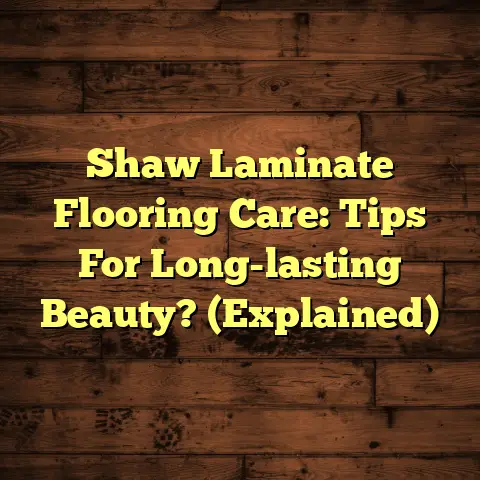Silicone Paper Under Hardwood Floors: Pros & Cons?
Ever walked into a room and felt instantly
at home?
A lot of that comes down to the
flooring.
I’ve seen it time and again – the
right floor can transform a space.
Imagine this: A living room, beautiful
hardwood floors, but… creak, creak, creak
with every step.
Winter rolls around, and
suddenly, it’s like walking on ice.
The
wood looks dull, almost lifeless.
Now, picture the same room.
The hardwood
gleams, rich and warm.
No more creaks,
just a solid, satisfying feel underfoot.
And that winter chill?
Gone.
The secret?
Silicone paper underlayment.
But is silicone paper always the answer?
Let’s dive deep into the world of
underlayments and uncover the pros and
cons of using silicone paper under your
hardwood floors.
Section 1: Understanding Silicone Paper
Okay, so what is silicone paper, exactly?
It’s not just your average baking parchment
gone wild!
Silicone paper, also known as silicone
release paper, is a paper base coated with
silicone.
This coating gives it some
unique properties, primarily its non-stick
nature and resistance to moisture.
Think of it as a barrier.
In construction, you’ll often find it used
as a release liner for adhesives, tapes,
and other sticky materials.
It prevents
them from bonding to surfaces they shouldn’t.
In flooring, specifically with hardwood,
we use it as an underlayment.
It sits
between the subfloor and the hardwood
planks.
This provides several benefits,
which we’ll get into shortly.
Think of it like this: Your subfloor is the foundation, the silicone paper is a protective layer, and your beautiful hardwood is the star of the show!
Section 2: The Pros of Using Silicone Paper
Under Hardwood Floors
Alright, let’s talk about the good stuff!
Why would you even consider silicone paper
under your hardwood?
Moisture Barrier
This is a big one, folks.
Wood and water
are not friends.
A silicone paper
underlayment acts as a moisture barrier,
protecting your hardwood from potential
water damage.
Think about it: concrete subfloors can
wick up moisture from the ground.
Even wood
subfloors can be susceptible to humidity.
This moisture can warp, cup, and even rot
your beautiful hardwood.
The silicone coating prevents this moisture
from reaching the wood, extending the life
of your floor.
I’ve seen floors saved from
disaster thanks to a simple moisture
barrier.
Sound Absorption
Ever live in an apartment with noisy
neighbors?
Or maybe you’re the noisy
neighbor?
Sound absorption is key!
Silicone paper helps dampen sound
transmission.
It won’t completely soundproof
your floor, but it will significantly reduce
noise.
Think about footsteps, dropped objects, or
even just the general hum of daily life.
The silicone paper absorbs some of that
sound energy, creating a quieter, more
peaceful living space.
I’ve had clients tell me the difference was night and day after installing silicone paper under their hardwood.
Comfort and Insulation
Nobody likes a cold floor on a chilly
morning, right?
Silicone paper provides a
degree of thermal insulation.
It’s not like having radiant heat, but it
does help to keep your floors warmer in the
winter and cooler in the summer.
It acts as
a buffer between the cold subfloor and your
hardwood.
This can translate to lower energy bills and a more comfortable home overall.
Ease of Installation
Compared to some other underlayment options,
silicone paper is relatively easy to
install.
It’s lightweight, easy to cut, and
rolls out smoothly.
I’ve worked with some underlayments that
are heavy, bulky, and a pain to work with.
Silicone paper is much more manageable.
This can save you time and effort, especially if you’re a DIY enthusiast.
Durability
Silicone paper is pretty tough stuff.
It’s
resistant to wear and tear, and it can
withstand the pressure of foot traffic and
furniture.
This contributes to the overall lifespan of
your flooring.
A durable underlayment helps
to protect your hardwood from damage and
extend its life.
Eco-Friendly Options
More and more manufacturers are offering
eco-friendly versions of silicone paper.
These options are often made from recycled
materials or use sustainable manufacturing
processes.
If you’re concerned about the environmental impact of your flooring project, look for these eco-friendly options.
Section 3: The Cons of Using Silicone Paper
Under Hardwood Floors
Okay, so it’s not all sunshine and roses.
Let’s talk about the potential downsides of
using silicone paper.
Cost Factors
Silicone paper can be more expensive than
some other underlayment options, like felt
or foam.
This is especially true for higher-
quality, thicker silicone paper.
While the benefits may outweigh the cost for some, it’s important to factor this into your budget.
I always tell my clients to get multiple quotes and compare prices before making a decision.
Compatibility Issues
Silicone paper isn’t always the best choice for every type of hardwood flooring or installation method.
For example, some engineered hardwood
floors may require a specific type of
underlayment to maintain their warranty.
Always check the manufacturer’s
recommendations.
Also, if you’re using a glue-down installation method, silicone paper may not provide the necessary adhesion.
Potential Slippage
This is a concern that I’ve heard from some
installers.
Because of the silicone
coating, there’s a potential for the
hardwood planks to slip or slide on the
underlayment if it’s not installed
correctly.
Proper installation is key to preventing
this.
Make sure the subfloor is clean, level,
and dry.
Use the appropriate adhesive or
fasteners to secure the hardwood planks.
Limited Cushioning
Compared to some other underlayment materials, like cork or rubber, silicone paper provides limited cushioning.
If you’re looking for a floor that’s soft and comfortable underfoot, silicone paper might not be the best choice.
Perception of Quality
Let’s be honest, silicone paper doesn’t always have the same “premium” perception as some other underlayment options.
Some people might view it as a cheaper,
less effective alternative to cork or rubber.
However, this isn’t necessarily true.
Silicone paper can be a great choice for certain applications, but it’s important to understand its limitations.
Section 4: Real-Life Experiences and Case Studies
Okay, enough with the theory!
Let’s hear
from some real people who have used silicone
paper under their hardwood floors.
I’ve talked to homeowners who swear by it, citing the moisture barrier and sound absorption as major benefits.
One homeowner told me that she had a
chronic moisture problem in her basement.
After installing silicone paper under her
hardwood floors, the problem completely
disappeared.
Another homeowner raved about how much
quieter her apartment was after installing
silicone paper.
She said she could finally
relax without hearing every footstep from
her upstairs neighbors.
However, I’ve also heard some negative
experiences.
One installer told me that he
had a problem with the hardwood planks
slipping on the silicone paper.
He had to
redo the entire floor.
Another homeowner complained that the
silicone paper didn’t provide enough
cushioning.
She said her feet were sore
after standing on the floor for long
periods of time.
Here’s a quick case study:
Project: Installing solid oak hardwood floors in a new construction home in a humid climate.
Challenge: High humidity levels and the potential for moisture to seep into the concrete subfloor.
Solution: Installing a silicone paper underlayment with a high moisture vapor transmission (MVT) rating.
Result: The silicone paper effectively
blocked moisture from reaching the hardwood
floors, preventing warping and cupping.
The
homeowners were happy with the results.
Another case study:
Project: Replacing carpet with engineered hardwood floors in a condo building.
Challenge: Strict noise regulations and the need to minimize sound transmission to neighboring units.
Solution: Installing a thicker silicone paper underlayment with a high sound transmission class (STC) rating.
Result: The silicone paper significantly reduced noise transmission, satisfying the building’s noise regulations and keeping the neighbors happy.
These are just a few examples.
Every
project is different, and the best
underlayment choice will depend on your
specific needs and circumstances.
Section 5: Conclusion
So, what’s the verdict? Is silicone paper a good choice for your hardwood floors?
The answer, as always, is “it depends.”
Silicone paper offers some significant
benefits, including moisture protection,
sound absorption, and ease of installation.
However, it can be more expensive than some
other options, and it may not be suitable
for all types of hardwood flooring or
installation methods.
Ultimately, the best way to decide is to weigh the pros and cons based on your individual needs and preferences.
Consider your budget, the type of hardwood flooring you’re using, the climate you live in, and your desired level of comfort and sound insulation.
Talk to a flooring professional.
Get their
expert opinion and ask them to assess your
specific situation.
And remember, proper installation is key to getting the most out of your underlayment, regardless of which type you choose.
Call to Action
Now, I want to hear from you!
Have you
used silicone paper under your hardwood
floors?
What was your experience like?
Share your thoughts and experiences in the
comments below.
Let’s start a conversation
and help each other make informed decisions
about our flooring projects!





